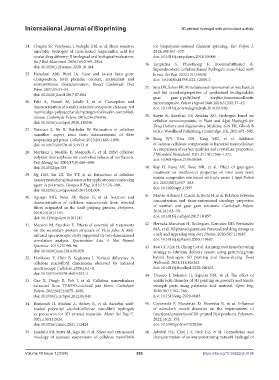Page 263 - IJB-10-1
P. 263
International Journal of Bioprinting 3D-printed hydrogel with antioxidant activity
24. Chegini SP, Varshosaz J, Sadeghi HM, et al. Shear sensitive for biopolymer-assisted filament spinning. Eur Polym J.
injectable hydrogels of cross-linked tragacanthic acid for 2018;109:367–378.
ocular drug delivery: Rheological and biological evaluation. doi: 10.1016/j.eurpolymj.2018.10.006
Int J Biol Macromol. 2020;165:2789–2804. 36. Tanpichai S, Phoothong F, Boonmahitthisud A.
doi: 10.1016/j.ijbiomac.2020.10.164
Superabsorbent cellulose-based hydrogels cross-liked with
25. Hamdani AM, Wani IA. Guar and locust bean gum: borax. Sci Rep. 2022;12(1):8920.
Composition, total phenolic content, antioxidant and doi: 10.1038/s41598-022-12688-2
antinutritional characterization. Bioact Carbohydr Diet 37. Jena DK, Sahoo PK. Simultaneous improvement of mechanical
Fibre. 2017;11:53–59.
doi: 10.1016/j.bcdf.2017.07.004 and fire retardantproperties of synthesised biodegradable
guar gum-g-poly(butyl acrylate)/montmorillonite
26. Feki A, Hamdi M, Jaballi I, et al. Conception and nanocomposite. Polym Degrad Stab. 2018;31(10):37–45.
characterization of a multi-sensitive composite chitosan-red doi: 10.1016/j.polymdegradstab.2018.05.020
marine alga-polysaccharide hydrogels for insulin controlled-
release. Carbohydr Polym. 2016;236:116046. 38. Kayra N, Koraltan YP, Aytekin AO. Hydrogels based on
doi: 10.1016/j.carbpol.2020.116046 cellulose nanocomposites, in Plant and Algal Hydrogels for
Drug Delivery and Regenerative Medicine, Giri TK, Ghosh B
27. Varanasi S, He R, Batchelor W. Estimation of cellulose (eds.), Woodhead Publishing, Cambridge, UK, 2021;471–505.
nanofiber aspect ratio from measurements of fibre
suspension gel point. Cellulose. 2013;20:1885–1896. 39. Bang WY, Kim DH, Kang MD, et al. Addition
doi: 10.1007/s10570-013-9972-9 of various cellulosic components to bacterial nanocellulose:
A comparison of surface qualities and crystalline properties.
28. Martínez J, Morillo E, Maqueda C, et al. Ethyl cellulose J Microbiol Biotechnol. 2021;31(10):1366–1372.
polymer microspheres for controlled release of norfluazon. doi: 10.4014/jmb.2106.06068
Pest Manag Sci. 2001;57(8):688–694.
doi: 10.1002/ps.339 40. Ray D, Rana AK, Bose NR, et al. Effect of guar-gum
treatment on mechanical properties of vinyl ester resin
29. Ng HM, Sin LT, Tee TT, et al. Extraction of cellulose
nanocrystals from plant sources for application as reinforcing matrix composites reinforced with jute yarns. J Appl Polym
agent in polymers. Compos B Eng. 2015;75:176–200. Sci. 2005;98(2):557–563.
doi: 10.1016/j.compositesb.2015.01.008 doi: 10.1002/app.21995
30. Aguayo MG, Pérez AF, Reyes G, et al. Isolation and 41. Martín-Alfonso J, Cuadri A, Berta M, et al. Relation between
characterization of cellulose nanocrystals from rejected concentration and shear-extensional rheology properties
fibers originated in the kraft pulping process. Polymers. of xanthan and guar gum solutions. Carbohydr Polym.
2018;10(10):1145. 2018;181:63–70.
doi: 10.3390/polym10101145 doi: 10.1016/j.carbpol.2017.10.057
31. Mecozzi M, Sturchio E. Effects of essential oil treatments 42. Herrada-Manchon H, Rodríguez-González DD, Fernández
on the secondary protein structure of Vicia faba: A mid- MA, et al. 3D printed gummies: Personalized drug dosage in
infrared spectroscopic study supported by two-dimensional a safe and appealing way. Int J Pharm. 2020;587:119687.
correlation analysis. Spectrochim Acta A Mol Biomol doi: 10.1016/j.ijpharm.2020.119687
Spectrosc. 2015;137:90–98. 43. Kuo CC, Qin H, Cheng Y, et al. An integrated manufacturing
doi: 10.1016/j.saa.2014.08.020 strategy to fabricate delivery system using gelatin/alginate
32. Horikawa Y, Clair B, Sugiyama J. Varietal difference in hybrid hydrogels: 3D printing and freeze-drying. Food
cellulose microfibril dimensions observed by infrared Hydrocoll. 2021;111:106262.
spectroscopy. Cellulose. 2008;16:1–8. doi: 10.1016/j.foodhyd.2020.106262
doi: 10.1007/s10570-008-9252-2 44. Triyono J, Sukanto H, Saputra RM, et al. The effect of
33. Cao X, Dingb B, Yub J, et al. Cellulose nanowhiskers nozzle hole diameter of 3D printing on porosity and tensile
extracted from TEMPO-oxidized jute fibers. Carbohydr strength parts using polylactic acid material. Open Eng.
Polym. 2012;90(2):1075–1080. 2020;10(1):762–768.
doi: 10.1016/j.carbpol.2012.06.046 doi: 10.1515/eng-2020-0083
34. Baniasadi H, Madani Z, Ajdary R, et al. Ascorbic acid- 45. Czyżewski P, Marciniak D, Nowinka B, et al. Influence
loaded polyvinyl alcohol/cellulose nanofibril hydrogels of extruder’s nozzle diameter on the improvement of
as precursors for 3D printed materials. Mater Sci Eng C. functional properties of 3D-printed PLA products. Polymers.
2021;130:112424. 2022;14(2): 356.
doi: 10.1016/j.msec.2021.112424 doi: 10.3390/polym14020356
35. Lundahl MJ, Berta M, Ago M, et al. Shear and extensional 46. Adedeji OE, Choi J-Y, Park GE, et al. Formulation and
rheology of aqueous suspensions of cellulose nanofibrils characterization of an interpenetrating network hydrogel of
Volume 10 Issue 1 (2024) 255 https://doi.org/10.36922/ijb.0164

